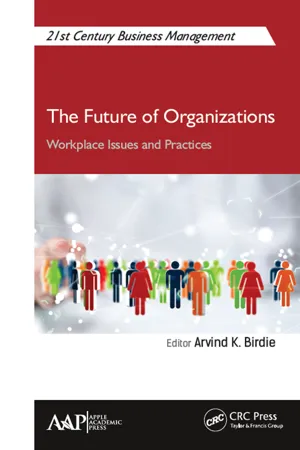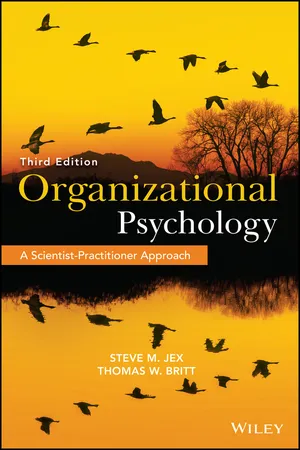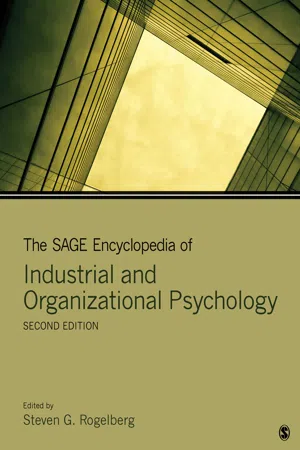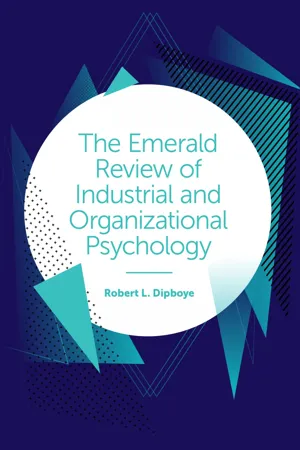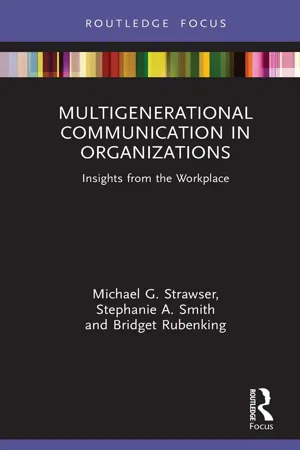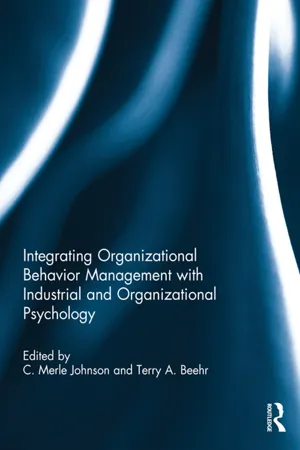Business
Job Satisfaction
Job satisfaction refers to an individual's contentment and fulfillment with their job. It encompasses various factors such as work environment, relationships with colleagues, compensation, and opportunities for growth. High job satisfaction is linked to increased productivity, employee retention, and overall organizational success.
Written by Perlego with AI-assistance
Related key terms
Related key terms
1 of 4
Related key terms
1 of 3
10 Key excerpts on "Job Satisfaction"
- eBook - ePub
The Future of Organizations
Workplace Issues and Practices
- Arvind K. Birdie, Arvind K. Birdie(Authors)
- 2018(Publication Date)
- Apple Academic Press(Publisher)
Successful organizations recognize that their employees are the primary source of achieving productivity and performance and, therefore, also care about their satisfaction. Job Satisfaction has been studied both as a consequence of many individual and work environment characteristics and as an antecedent to many outcomes (Chahal et al., 2013). Lease (1998) noted that employees with higher Job Satisfaction are usually less absent, less likely to leave, more productive, more likely to display organizational commitment, and more likely to be satisfied with their lives. The concept of Job Satisfaction is multifaceted and can be defined in various ways. Job Satisfaction can be defined as a positive emotional state resulting from the appraisal of one’s job or job experiences Locke and Lathan (1990). Hackman and Oldham (1975)’s job characteristic model (JCM) has been used to determine the level of Job Satisfaction and focuses on five core job dimensions: (1) skill variety, (2) task identity, (3) task significance, (4) autonomy, and (5) feedback, which in turn influence three key psychological states: experienced meaningfulness of the work, experienced responsibility for the work, and knowledge of results.Authors like Jayasuriya et al. (2012) and Ezeja et al. (2010) define Job Satisfaction as pleasant and positive emotional reaction to an individual’s perception of his/her work, and it is important, particularly, in internal perception of an individual’s values and their relationship to the perception of current working conditions. Job Satisfaction can be defined as an emotional response in the working environment (Armstrong, 2006). Armstrong (2006) points out that the term Job Satisfaction refers only to the attitudes and emotions of individuals regardless of their work. This means that a positive and favorable attitude towards their own workplace reflects an individual’s Job Satisfaction, and on the other hand, negative and unfavorable attitude towards one’s own workplace reflects an individual’s dissatisfaction in the workplace. - Elizabeth George, Zakkariya K.A.(Authors)
- 2018(Publication Date)
- Palgrave Pivot(Publisher)
Job Satisfaction is especially important for service industry employees because it is assumed that if only employees are satisfied with their jobs can they provide good quality service to their customers. It is not the customers alone who should be satisfied but the employees of the organization should also be satisfied in order to achieve customer satisfaction.4.1.1 Definitions of Job Satisfaction
The pleasurable emotional state arising from the appraisal of one’s job or job experiences is called Job Satisfaction (Locke 1976 ). That is, when a person values a particular facet of a job, his or her satisfaction is greatly impacted positively when expectations are met and is negatively impacted when expectations are not met compared to an employee who doesn’t value that facet. Below are several definitions of Job Satisfaction .Job Satisfaction or dissatisfaction is a function of perceived relationship between what one expects and obtains from one’s job and how much importance or value he attributes to it (Kemelgor 1982 ).Job Satisfaction refers to people’s feelings about the rewards they have received on the job (Lawler 1990 ).Job Satisfaction is defined as an attitude that individuals have about their jobs which results from their perception of the jobs and the degree to which there is a good fit between the individual and the organization. Employees in flat organization are more satisfied than employees in narrow span of organization as they have more control of their work and decision-making power (Ivancevich et al. 1997 ; Ivancevich and Matteson 1980- eBook - ePub
Organizational Psychology
A Scientist-Practitioner Approach
- Steve M. Jex, Thomas W. Britt(Authors)
- 2014(Publication Date)
- Wiley(Publisher)
In this sense, Job Satisfaction is basically employees' attitudes toward their job (see Eagly & Chaiken, 1993). Like all attitudes, Job Satisfaction consists of feelings, thoughts, and behaviors individuals have relevant to their jobs (Breckler, 1984). Most authors emphasize the emotional component of Job Satisfaction. However, cognitive and behavioral components of Job Satisfaction are important aspects of the construct as well (Schleicher, Hansen, & Fox, 2011). The cognitive aspect of Job Satisfaction represents employees' beliefs about their job or job situation; that is, employees may believe that their job is interesting, stimulating, dull, or demanding—to name a few options. Note that although these represent cognitive beliefs, they are not completely independent of the previously described affective component. For example, a statement or belief that “My job is interesting” is likely to be strongly related to feelings of positive affect. The behavioral component represents employees' behaviors or, more often, behavioral tendencies toward their job. Employees' levels of Job Satisfaction may be revealed by the fact that they try to attend work regularly, work hard, and intend to remain members of the organization for a long period of time. Compared to the affective and cognitive components of Job Satisfaction, the behavioral component is often less informative because one's attitudes are not always consistent with one's behavior (Fishbein, 1979). It is possible, for example, for employees to dislike their job but still remain employed there because of financial considerations. In addition, Dalal (2013) points out that a great deal of research has established the conditions under which affective and cognitive components of attitudes are related to behavioral outcomes - Steven G. Rogelberg(Author)
- 2016(Publication Date)
- SAGE Publications, Inc(Publisher)
Job Satisfaction Job Satisfaction Sharon K. Parker Sharon K. Parker Parker, Sharon K. 803 808 Job Satisfaction Sharon K. Parker Job Satisfaction refers to the overall feelings one has and the evaluation one makes about one’s job. People with high job satisfaction experience a pleasurable or positive emotional state when they think about their job or job experiences. In simple terms, they like their jobs. Since early studies in the 1930s, Job Satisfaction has become one of the most widely investigated concepts in the field of industrial and organizational psychology. It is a valuable outcome in its own right but also a driver of other important individual and organizational outcomes. The importance of this concept is reflected in its central role in numerous theories, such as those concerning job design, leadership, and employee withdrawal. Defining and Measuring Job Satisfaction Job Satisfaction is traditionally defined as a pleasurable or positive emotional state that results from one’s appraisal of one’s job or job aspects. This definition includes both one’s affective reactions to one’s job (feelings) and one’s cognitive evaluation of the job (thoughts). There is controversy about whether Job Satisfaction should be considered as the interplay of both one’s thoughts and feelings, as implied in this definition, or whether the cognitive and affective aspects should be separated into distinct dimensions- Robert L. Dipboye(Author)
- 2018(Publication Date)
- Emerald Publishing Limited(Publisher)
The Affective Event Theory states that, over time, recurring moods and emotions at work lead to more permanent work-related attitudes (Weiss & Cropanzano, 1996). Specifically, employees form attitudes toward facets of their work (e.g., coworkers, supervisor, work itself) around the strong and recurring affective reactions to work events. In addition to the average of day-to-day affective responses to work events, the variability around this average also influences Job Satisfaction. Xu, Martinez, Van Hoof, Eljuri, and Arciniegas (2016) found that employees who were more variabile in their emotions at work had lower Job Satisfaction. They further found that emotional exhaustion mediated the effect of variability on Job Satisfaction. Apparently, swings in emotion required more cognitive resources to manage the emotion, exhausting the employee and lowering Job Satisfaction.Outcomes of Job Satisfaction/Dissatisfaction
A century of research shows that higher Job Satisfaction is associated with a variety of positive outcomes. Table 4.1 contains the results of several meta-analyses. To summarize, a satisfied employee- is less frequently absent from work;
- is less likely to leave the job (turnover);
- is less frequently late to work;
- tends to show more organizational citizenship (behaviors that help out coworkers and others but are not required as part of the job);
- is less likely to show counterproductive behavior such as fighting, theft, and the like;
- receives more positive supervisory performance ratings;
- performs more effectively on objective measures;
- rates his or her own performance more positively;
- is more committed to the organization;
- evaluates his or her life satisfaction and happiness more positively;
- reports less role stress (conflict and ambiguity);
- is mentally healthier;
- is physically healthier.
This is an impressive list of benefits that appears to support the Human Relations assertion that management should do whatever it can to increase employee satisfaction with the job. However, there are complications. First, we cannot infer causality from these correlational results. Job Satisfaction could be the outcome of the other variable or both could be caused by a third variable. A second complication is that correlates of Job Satisfaction (e.g., stress, mental health) contain some items similar to or identical with items in the Job Satisfaction measures. Also, the use of self-report in both the satisfaction measures and the measures of the other variables raises the possibility of common method bias. Both item overlap and common method bias would have the effect of inflating the correlations. A final complication is variability across situations in the size and the direction of correlations. There are situations in which satisfaction is positively related to outcomes and other situations in which there is no relation or even a negative relation. These variations may reflect the moderating influence of third variables on the satisfaction–outcome relation. Perhaps the most important question is whether a happy worker is also a high performing worker. Consequently, I will focus on the correlation with performance in elaborating on these complications.- eBook - ePub
Leadership and Cultural Change
Managing Future Well-Being
- Ramona Houmanfar, Mark Mattaini, Ramona Houmanfar, Mark Mattaini(Authors)
- 2018(Publication Date)
- Routledge(Publisher)
Job Satisfaction is the most widely researched variable in industrial-organizational psychology (Spector, 1997). This literature is bursting with studies of assorted antecedents, mediators, and moderators of Job Satisfaction. It is also filled with copious correlates of Job Satisfaction, such as various organizationally important attitudes and behaviors, primarily as an argument for its importance (Judge, Piccolo, Podsakoff, Shaw, & Rich, 2010; Judge, Thoresen, Bono, & Patton, 2001). The present article is less concerned with these issues, which view Job Satisfaction as a management tool, but rather approaches Job Satisfaction as a leadership responsibility, organizational leadership obligation, and ethical imperative (Hocutt, 2013; Mawhinney, 1984, 1989, 2011) and as a necessary outcome of successful organizational behavior management (OBM) interventions. Rather than sliding into scholasticism regarding the mensurational and definitional issues surrounding Job Satisfaction, the working definition adopted herein is quite simple: following Spector (1997, p. 2), “the extent to which people like (satisfaction) or dislike (dissatisfaction) their jobs,” or Job Satisfaction = affective response to work, workplace conditions, and the work environment.BEGINNING WITH A QUIZ As is common in many academic endeavors, we will begin with a quiz. Where do adults in industrial and postindustrial societies spend the majority of their conscious, waking hours? What is perhaps the largest influence on adults’ daily emotional well-being? What is a substantial determinant of adults’ health, quality of family life, and community involvement?The answer to all of the above is “the workplace.” According to the Gallup Work and Education Poll (Saad, 2014), in 2013–2014 salaried employees in the United States worked an average of 49 hr/week and 50% worked more than 50 hr/week. Hourly employees worked an average of 44 hr/week, with 26% working more than 50 hr/week. Similarly, the American Time Use Survey (Bureau of Labor Statistics, 2014) showed that adults in the United States spend more time working than engaging in any other conscious activity; sleep occupies only slightly more time.Work, the workplace, working conditions, and the daily experience of work are fundamentally important, or possibly the most critically important factors in adult psychological functioning. By extension, a parent’s work experience may also well be one of the most significant foundations of children’s emotional, intellectual, and social development, because parents’ daily encounters at work directly affect their interactions with their children when they come home. The economic benefits that work brings dictate the quality of neighborhoods, schools, and opportunities, and adults’ modeling of work-related behavior and reactions to work might serve as powerful instructions and examples to their children. Indeed, it can be argued that the workplace is the single greatest influence on human psychology in postindustrial daily life. The growing literature on work–life balance makes these points abundantly clear (Bulger & Fisher, 2012; Kossek, Valcour, & Lirio, 2014). - eBook - ePub
Multigenerational Communication in Organizations
Insights from the Workplace
- Michael G. Strawser, Stephanie A. Smith, Bridget Rubenking(Authors)
- 2021(Publication Date)
- Routledge(Publisher)
MetLife, 2019 ).9.2.1 Previous Research and Theory
As previously mentioned earlier in this chapter, Job Satisfaction is a multidimensional construct that is influenced by several other factors, including, but not limited to: organizational culture, communication, leadership, personality, and teleworking. This section will briefly outline some of the previous research findings related to Job Satisfaction, with the note that this is not an exhaustive overview of this multidimensional construct that is a robust area of research.An early model of Job Satisfaction research proposed the two-factor model (Herzberg, Maunser, & Snyderman, 1959 ), which later gave way to the global approach for understanding Job Satisfaction. The global approach studies separate job parts that are likely to promote or prevent an individual’s level of Job Satisfaction (Sowmya & Panchanatham, 2011 ). This informed another model of Job Satisfaction by Hackman and Oldman (1975) , which considered five variables to create “motivating potential,” which is the degree to which an employee’s motivation can be influenced. Over time, researchers turned to more cognitive conceptualizations of Job Satisfaction, which is where the field remains today, examining variables that include the employee’s needs and how they perceive Job Satisfaction.Through cognitive research, we have learned Job Satisfaction is dependent on many things beyond an employee’s frame of mind and also influenced by organizational factors like culture, size, salary, and working conditions or environment. For example, there is a large body of work that examines the Job Satisfaction of teleworking employees, which has become a renewed interest due to the pandemic that occurred in 2020 and forced organizations to allow many employees to work remotely. - eBook - ePub
- C. Merle Johnson, Terry Beehr, C. Merle Johnson, Terry A. Beehr(Authors)
- 2013(Publication Date)
- Routledge(Publisher)
C. Smith (1967) defined JS “as an affective response of the worker to his job... [and is]... similar in meaning to pleasure” (p. 343; emphasis added). She went on to lament “the fact that there is no necessary connection between productivity and satisfaction” (p. 343). Schleicher, Hansen, and Fox (2010) recognize another two definitions of satisfaction involving affect and emotion: first, Locke’s (1969) conception of it as a “state resulting from an employee’s perception that his or her job allowed for the fulfillment of his or her values,” and Cranny, Smith, and Stone (1992) characterized JS as “an emotional state resulting from an employee’s comparison of actual and desired job outcomes” (p. 148). The second approach identified by Schleicher et al. (2010; citing Rosenberg & Hoveland, 1960) characterizes JS “as an attitude, rather than (and distinct from) an emotional state.” Job attitudes are not behavior, rather they are “personal construct [s] [P c s] [emphasis added] that can be used to describe people [emphasis added]” (Zedeck, 2010, p. xxii). And these constructs, manifest as scores on JS surveys, play the role of P c in IOP’s grand theory. Often, performance behavior, B c, is measured by supervisors’ ratings (Schleicher et al., 2010, p. 153, Table 4.1). Note behavior may itself be a construct. Organizational citizenship behavior (OCB) is a construct, B c, typically assessed via paper and pencil responses about behavior descriptions on rating scales (Organ, Podsakoff, & MacKenzie, 2006), rather than tangible behavior per se or tangible consequences of behavior in the traditions of OBM (Gilbert, 1978) - Peter Y. Chen, Cary Cooper, Cary Cooper, Peter Y. Chen(Authors)
- 2014(Publication Date)
- Wiley-Blackwell(Publisher)
Half a century of active research has been unable to establish a strong link between Job Satisfaction and performance. Notwithstanding renewed interest, evidence to support the proposition that happy workers perform better is still not compelling, as subsequent studies have found only modest support for this predicted relationship. Despite the lack of empirical evidence, the notion that happy workers are more productive is firmly entrenched in management ideology (Cropanzano & Wright, 1999, 2001; Ledford, 1999; T. A. Wright & Cropanzano, 2000; T. A. Wright, Cropanzano, Denney, & Moline, 2002; T. A. Wright & Staw, 1999a, 1999b). Despite these mixed and often contradictory findings, a veritable stream of research and theory building may be found into the happy–productive worker thesis that is both “important and worthy” of investigation (West, Arnold, Corbett, & Fletcher, 1992, p. 1), as it “begins to make a claim on our attention” (Christensen, Andrews, & Porter, 1982, p. 6).Job Satisfaction and Worker Performance
Earlier research has also been unable to establish a close link between Job Satisfaction and performance (cf. Brayfield & Crockett, 1955; Iaffaldano & Muchinsky, 1985; Locke, 1976; Porter, 1963; Vroom, 1964). Undeterred by these findings, Brief (1998, p. 43) stated, “I still suspect a consistent, significant Job Satisfaction/task performance relationship is out there to be found.” A review of the literature by Spector (1997) indicated that more satisfied workers are more cooperative toward coworkers, punctual, time efficient, have fewer days off work, and remain with organizations longer than their colleagues who had lower levels of Job Satisfaction. Worker psychological wellbeing has been found to be in the best interests of employers (Harter, Schmidt, & Hayes, 2002).A meta-analysis by Harter and colleagues (2002) of the relationship between worker perceptions of the workplace and business unit outcomes found a positive relationship between Job Satisfaction and worker performance, especially aspects of satisfaction with supervisors and satisfaction with work. Later meta-analyses have indicated that there is a stronger relationship between Job Satisfaction and job performance than was previously evident (Harter, Schmidt, & Hayes, 2002; Judge, Thoresen, Bono, & Patton, 2001). However, overall the average observed relationship between Job Satisfaction and performance is positive but relatively weak, ranging from 0.14 to 0.25 (Judge et al., 2001). But a strong association (r- eBook - ePub
The Psychology of Behaviour at Work
The Individual in the Organization
- Adrian Furnham(Author)
- 2012(Publication Date)
- Psychology Press(Publisher)
et al. concluded thus:Drawing from the tripartite (cognitive, affective, and behavioral) categorization of attitudes, the Big Five traits may influence Job Satisfaction through each of these processes. Cognitively, these traits may influence how individuals interpret characteristics of their jobs, as is the case when individuals with positive core self-evaluations interpret intrinsic job characteristics more positively, even controlling for actual job complexity. Affectively, these traits might influence Job Satisfaction through their effect on mood or mood at work. Finally, behaviourally, employees who are Emotionally stable, Extraverted and Conscientious may be happier at work because they are more likely to achieve satisfying results at work. Part of this effect may operate through job performance, such that Conscientious employees perform better and are more satisfied with their jobs because of the intrinsic and extrinsic rewards that high performance provides. In part, it may operate through situation selections, such that Extraverted employees are more likely to spend time in situations that make people happy, such as in social interactions. Given the links between personality and job performance, and personality and Job Satisfaction presented herein, perhaps the time has come for a framework that takes the linkages among personality, job performance, and Job Satisfaction into account. Such models may involve more proximal predictors, such as integrity, which is related to the five-factor model. (Judge et al., 2002: 536)Need theoriesNeed theories are based on the simple idea that work-related behaviours are directed to satisfying certain needs. Depending on the type and quality of that need, people will strive in, and outside, work to satisfy them.
Index pages curate the most relevant extracts from our library of academic textbooks. They’ve been created using an in-house natural language model (NLM), each adding context and meaning to key research topics.
Explore more topic indexes
Explore more topic indexes
1 of 6
Explore more topic indexes
1 of 4
